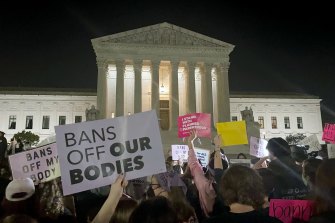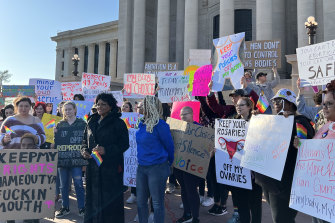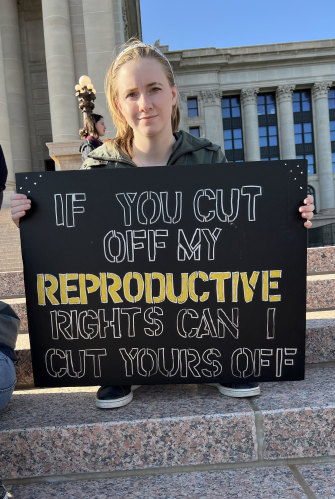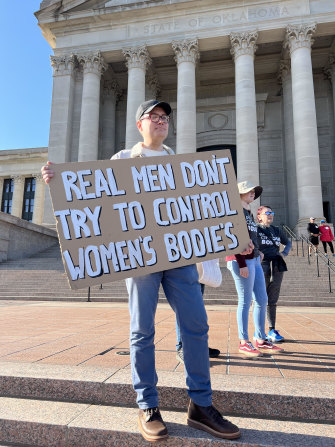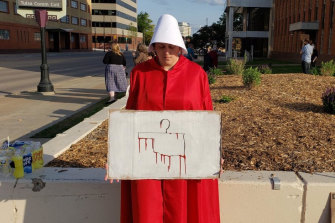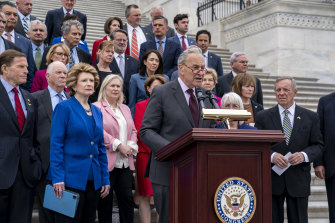Oklahoma: the latest frontier in America’s abortion wars
By Farrah Tomazin
Devney Johnson* was 29 when she made the agonising decision to have an abortion.
The mother of two had not wanted to get pregnant a third time, so when her birth control failed, she knew in her heart she couldn’t go through with it.
Crowds gathered outside the Supreme Court on Monday night after a draft was leaked suggesting Roe v Wade would be repealed.Credit:AP
Having another child would have resulted in more financial pressure and run the risk that her kids would not get the kind of life she wanted for them, she says. After six hours of considering her options, she called her local abortion clinic to schedule an appointment.
“Me and my husband both knew that we were not willing to let our family just barely survive,” Johnson tells The Age and The Sydney Morning Herald from her home in Tulsa, Oklahoma.
“We really wanted our family to thrive and we knew that if we had a third baby we couldn’t do that. It was really tough, but once I accepted that this was exactly the decision I needed to make for myself and my family, I could start to heal.”
It’s been three years since Johnson had the procedure, but she still remembers it as though it was yesterday: from the pro-life protesters yelling at her as she entered the clinic, to the volunteers escorting her from her car and shielding her with umbrellas until she was inside. But she also gratefully recalls the autonomy she had over her pregnancy – a fundamental right that is now being curtailed in the latest battle over women’s reproductive rights in America.
“I was really lucky because I got to choose – and now so many others don’t,” she says, her voice quivering with emotion. “That is atrocious.”
As the US Supreme Court decides the fate of Roe v Wade, the landmark 1973 decision legalising abortion in the US, Oklahoma has found itself at forefront of the nation’s abortion wars.
When Texas became the first US state to implement an abortion ban after six weeks of pregnancy last September – the strictest actively enforced prohibition in the country – thousands of Texans turned to neighbouring states for treatment.
Protesters gather for an abortion rally at the Oklahoma State Capitol.Credit:Farrah Tomazin
Oklahoma took on much of the load. Data released by Planned Parenthood in February showed that in the first four months since the Texas restrictions were introduced, Oklahoma clinics saw a nearly 2500 per cent increase in patients from the Lone Star state.
Now Oklahoma is facing its own healthcare crisis.
On Tuesday, Oklahoma Republican governor Kevin Stitt signed new laws copying the Texas model. Known as the Heartbeat Act, the law bans abortions once cardiac activity can be detected in an embryo, which experts say is roughly six weeks into a term – and before many women actually know they are pregnant.
The law is accompanied by a bounty-hunting scheme encouraging members of the public to sue those involved in abortions and rewarding them with at least $US10,000 if their lawsuit is successful.
A separate law, which will take effect in August, would make performing an abortion a crime punishable by up to 10 years in prison, or a maximum fine of $US100,000 ($132,000), or both.
Oklahoma is also one of several US states that have so-called “trigger” laws that would outlaw abortion entirely, except to save the life of a pregnant woman, as soon as the Supreme Court overrules “in whole or in part” the existing precedent established in Roe v Wade.
Tamya Cox-Toure, the executive director of the American Civil Liberties Union in Oklahoma, says that pro-choice groups had been anticipating abortion access becoming more limited, not just because of the looming Supreme Court decision but due to the “Texas-like copycat bills” that numerous Republican-led states have been pushing.
“I guess we’ve been living in a post-Roe world for a long time,” says Cox-Toure, whose group last week tried unsuccessfully to get a court injunction to thwart the latest changes.
“Women have had the right to abortion for the last 50 years, but access has always been difficult. Now it’s going to get worse, and just like in Texas, the impact of this ban will fall hardest on people struggling to make ends meet, people of colour and those living in rural areas.”
‘It’s like World War II’
There are only four abortion clinics in Oklahoma- two Planned Parenthood centres, the Tulsa Women’s Clinic, and Trust Women – all of which are located in the metropolitan districts of Tulsa or Oklahoma City.
In March, staff at Trust Women began cutting back on abortions in anticipation that the law could change at any time and they would be forced to cancel appointments. Nonetheless, the phones kept ringing, with the group receiving a daily average of 134 calls last month alone.
It’s a similar story about 10 kilometres north, in the plain grey building that makes up the Oklahoma City branch of Planned Parenthood.
Now they’re no longer booking abortions, the receptionist tells me, as she checks the scheduling system to see if there are any appointments available in Kansas or Arkansas, which border Oklahoma to the north and east.
“They don’t have anything at the moment, ma’am,” she says. “Maybe you could call back next week and see if anything has opened up?”
All the clinics have also been relying heavily on donations from groups such as the Roe Fund, a volunteer-run not-for-profit that provide centres with a lump sum every month to help women who need financial support for abortion services.
But pro-choice advocates say that the latest ban will merely exacerbate the squeeze, as more women have to travel further and wait longer for much-needed services. Others may seek an abortion outside the health care system, or carry pregnancies against their will.
“Even before any of these laws we already had run out of funds before the month ended because so many people were needing support,” says Gabriele Cano, one of six volunteers at the Roe Fund.
A pro-choice student holds up a sign in Oklahoma.Credit:Farrah Tomazin
“But now we’ve gotten referrals and requests for people wanting travel to Illinois, or to Colorado or to New Mexico, just because they’re a few days over six weeks.”
There’s also the process itself, which is far from easy under Oklahoma law. Once a woman decides to have an abortion, she must receive a state-sanctioned pamphlet detailing potential side effects and other information that critics claim is skewed to make patients rethink their choice.
She must also wait 72 hours before she can get an appointment, and once she finally gets one, clinics are required to give her a list of 32 questions asking about everything from her ethnicity to whether she’s being coerced. Abortions are also generally paid upfront, ranging between $US600 to $US800 for a standard procedure.
Nonetheless, the pro-life lobby argues that the latest changes don’t go far enough. Anti-abortion activist Randall Terry says he wants abortion restricted in all 50 states, telling The Age and Sydney Morning Herald: “All these steps are good but it’s like World War II. The allies took Normandy beach and that was a key victory, but the goal was to always get to Berlin.”
Sarah Zarr, the regional manager of Students for Life, has a more nuanced view. Like all the members of her group, the 28-year-old believes that life begins at conception and that abortions should not be permitted under any circumstance, even in the case of incest or rape.
But she adds the focus should be on improving services and education for women – something that Students for Life has been actively lobbying Republicans to include in abortion bills across the country.
“I used to volunteer at a rape centre and it’s so heartbreaking that anyone would have to go through something like that,” she says, “but we can either answer that violence with more violence in the form of an abortion, or we can answer it by giving women all the help and support they need.”
After the protests?
It’s shortly after 5pm when the evening sun bursts through the clouds above Oklahoma’s State Capitol Building on Lincoln Avenue, much to the relief of the protesters slowly gathering on its steps.
A man holds up a sign during a protest at the Oklahoma State Capitol.Credit:Farrah Tomazin
There are about 100 people in the crowd, from elderly residents to students and activists. Many of them take it in turns to grab the megaphone to give an impromptu speech; others simply listen and clap on cue, holding up colourful signs.
“Keep My Rights Name Out Ya F—ing Mouth,” reads one woman’s placard, channelling the rage of actor Will Smith after his now infamous Oscar slap against comedian Chris Rock.
“Real Men Don’t Try To Control Women’s Bodies,” says another, held by a man.
The Thursday evening rally was one of many across the US this week, sparked by the leaked Supreme Court document suggesting that America’s highest court is set to overturn the constitutional right of women to have an abortion in the US.
On Tuesday, protesters also gathered outside the Tulsa Courthouse to make their voices heard.
Among them was Shawna Black – donning a red Handmaid’s Tale outfit and a sign featuring a bloody coathanger in the shape of Oklahoma – who had driven 90 minutes from her home town of Tahlequah in Cherokee County with her husband.
Asked what spurred her, Black’s answer is simple: “Really when you’re banning abortions, you’re just banning safe abortions,” she says.
Shawna Black protesting at the Tulsa Courthouse in Oklahoma, where abortion is now banned after six weeks.
“Oklahoma already doesn’t have a great track record for children in foster care, or mental health care, or equity. So you’re really just damning women to die, or damning families and children to needlessly suffer. That alone should be enough to motivate anybody.”
The question, however, is where to from here?
After all, if the Supreme Court follows through with its plans to overturn Roe v Wade in the next two months, the Biden administration has few options to countermand the ruling.
Democrat Senate Majority Leader Chuck Schumer has announced a vote on Wednesday to codify Roe v Wade in federal law but without the required numbers, such a move is doomed to fail.
Senate Majority Leader Chuck Schumer plans to hold a vote to codify abortion law but the Democrats don’t have the numbers.Credit:AP
Therefore, with the midterm elections looming in November, the Democrats’ best bet might be to galvanise voters to turn up at the ballot box and elect more pro-choice officials.
Back at the Oklahoma State Capitol, the pro-choice protesters are hopeful.
“This is a much bigger fight, but we can do it if we stick together!” Reverend Diana Davies, who runs a progressive church in Oklahoma City, yells into the megaphone.
“I’m more afraid of us getting complacent than I am of the far right. We’ve got to step up like it matters.”
*not her real name
Get a note directly from our foreign correspondents on what’s making headlines around the world. Sign up for the weekly What in the World newsletter here.
Most Viewed in World
Source: Read Full Article
